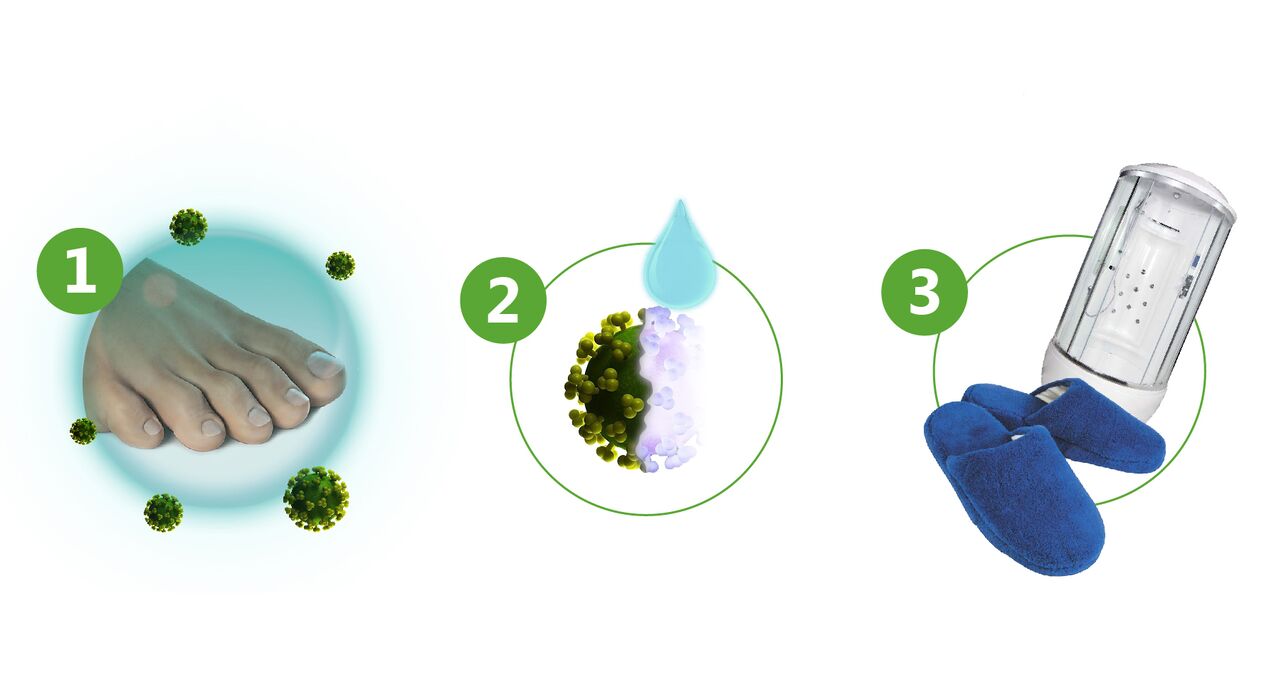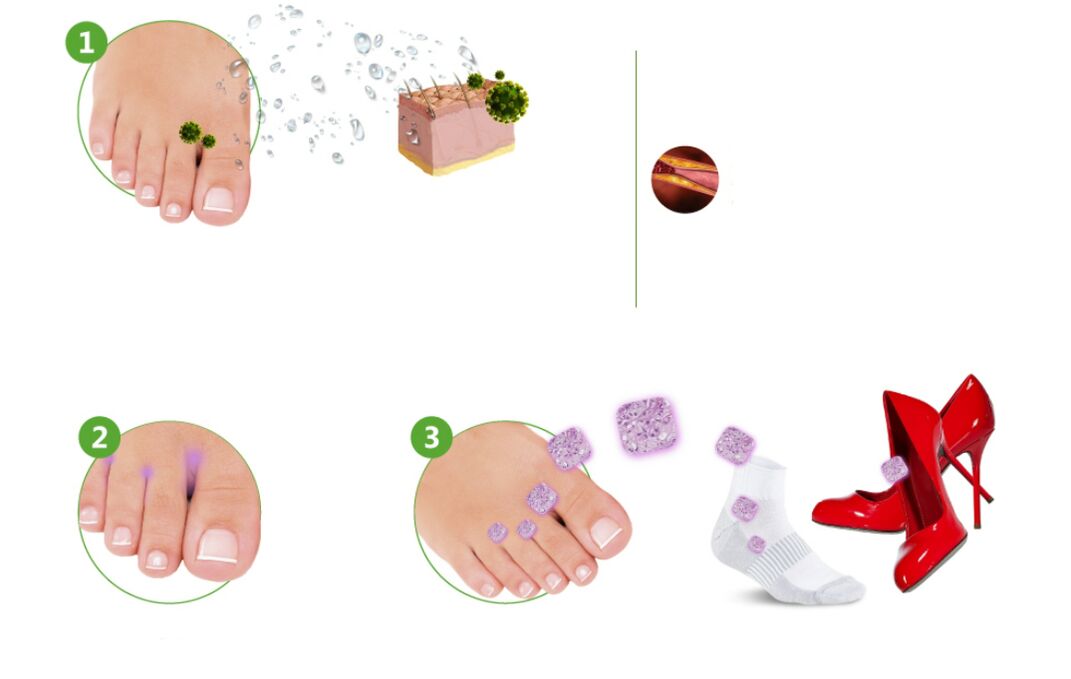One of the most common skin diseases is tinea pedis. It occurs in people of all ages and professions. The highest incidence of fungal diseases is among workers in hot shops, miners, athletes, bath house workers, in which the incidence exceeds 60%. The disease is quite rare in children, but in adolescents, the number of fungal infections is increasing.
What is foot fungus?
Mycosis of the feet is a group of fungal diseases of the skin, often with concomitant lesions of the nail. These infections cause similar clinical manifestations. They can only be distinguished after microscopic examination of the skin and nails. Ringworm of the feet is a very contagious disease. It is passed from person to person through household items: rugs in changing rooms, showers and pools, footstools, sinks and floors in baths and saunas. It is very dangerous to share shoes and socks. The surface layer of the skin, where scabs are frequent, contains a large number of fungi and their spores. Initially, the intervertebral folds are affected, skin itching. In the future, the infection captures the entire foot and spreads to the fingernails. The course of the disease is long, requiring continuous treatment. To prevent athlete's foot, you can purchase an effective prophylactic drug.

Causes of foot fungus
The cause of the disease is caused by microorganisms belonging to the genus Trichophyton, less commonly mold and Epidermophyton floccosum:

- red trichophyton (Tr. rubrum) causes up to 95% of all cases;
- about a third of patients also found trichophyton interdigital (Tr. interdigitale);
- Inguinal epidermophytosis (E. floccosum) is the causative agent in 1% of cases.
The likelihood of infection increases under adverse external conditions:
- high humidity;
- tight shoes;
- frequent visits to pools, saunas and other wet areas;
- presence of a sick person in the family.
Some medical diseases also contribute to the development of fungal infections:
- sweaty feet;
- immunodeficiency;
- the amount of corticosteroid hormone inside;
- flat feet;
- Raynaud's disease, peripheral atherosclerosis, obstructive endocarditis, varicose veins;
- Diabetes.

What happens when you get sick?
Foot fungus on healthy skin rarely develops. Even if the fungus grows on the surface, it will not be able to penetrate the thick layer of intact epithelium. Under the influence of adverse external factors, the epidermis accumulates moisture and loosens. The fungus penetrates the thickness of the skin and begins to actively multiply. This is further fueled by vascular diseases and immune disorders, accompanied by malnutrition and local defense mechanisms on the feet. The reproduction of the fungus causes damage to the interstitial areas, violent peeling causing discomfort to the patient. The removed epithelium enters socks and shoes, becoming a source of re-infection. Therefore, during the treatment of tinea versicolor, it is necessary to treat the inner surface of the shoes with a composition with a special composition against the fungus.

Symptom
Most often, there are such forms of foot fungus, which are shown in the photo:
- Scaly: One-sided peeling and mild itching of the arch of the foot. This form is generally not recognized.
- Intertriginous: the folds between the fingers are affected, then the process moves to the back of the foot. Cracks appear, accompanied by itching. Bacterial infections may accompany the development of erysipelas.
- Dyshidrotic: on the arch of the foot, blisters coalesce in the presence of light, and then turbidity. They open with the formation of painful erosions. This type is accompanied by itching and pain.
Toenail fungus in the acute period may be accompanied by fever, poor health, headache, enlarged inguinal lymph nodes. When infected with trichophyton, the nail of the I or V fingers will be affected, in the future this process will spread to all the nail plates. First, yellow spots appear on the free edge of the nail, then it thickens, loosens and scabs. Therefore, to treat foot fungus, you need to use products with a complex effect, for example, lotions for the skin and nails.

Diagnostic
Diagnosis of the disease is based on the analysis of external manifestations and the isolation of the fungus from the surface of the skin. A microscopic examination of the affected epithelium and nail is performed. To determine the exact type of microorganisms, they are cultured on nutrient medium. It is necessary to distinguish fungus of the foot from non-fungal lesions:
- intertrigo;
- eczema;
- Psoriasis;
- increased horns.
Accurate diagnosis ensures a good treatment outcome.
Treatment of foot fungus
Therapy is carried out in 2 stages. First, it is necessary to eliminate the acute inflammation and remove the stratum corneum on the feet. Shows a warm foot bath with potassium permanganate and a lotion with a boric acid solution. After removing the dense epithelium, creams containing anti-inflammatory hormones and antibiotics are used. After the inflammation subsides, these creams are replaced with similar ointments. At the second stage of treatment, antifungal ointments and creams are used (for example, representatives of the imidazole group of antifungal drugs). They should be applied to clean and dry skin 1-2 times a day, gently rubbing. Not only the affected area is treated, but also the surrounding surface of the foot. Treatment takes about a month. Toenail fungus is successfully treated with drugs, special lotions for the skin and nails, which you can buy in a pharmacy. Benefits of the drug in the fight against fungi:
- high activity against fungi that cause mycosis of the feet;
- Guard;
- hypoallergenic;
- good price.
The lotion can be used to treat other skin diseases:
- vitiligo;
- candidiasis of the skin;
- erythema;
- secondary bacterial infection against the background of fungal diseases.
The drug is used 2 times a day, gently rubbing into the affected areas. The skin must first be washed with soap and dry, especially between the fingers. The course of treatment lasts until the symptoms of the disease disappear and for another 2 weeks. The drug is well tolerated. Only occasionally does it cause skin irritation. He has only contraindication - the first trimester of pregnancy. Of course, clotrimazole is not used for individual intolerance. One of the advantages of lotions is the excellent penetration of the drug into the nail plates, which distinguishes it from creams or ointments. Regular use of this drug gives an excellent result in curing fungal diseases of the feet and nails without using extra funds. Damage to nails requires the appointment of antifungal drugs inside.
At the same time, use a therapeutic polish, apply to the nails 1-2 times a week until complete recovery.
Prevention methods
Treating a fungal infection takes a long time. Toenail fungus must use drugs, the cost is quite high. Prevention is especially important in people with risk factors for the disease. Athletes, swimmers, and hot shop employees should regularly use antifungal and antibacterial medications, such as sprays or lotions. Such products are very safe, do not hurt the skin and do not cause irritation. If used regularly, the possibility of foot fungus will be significantly reduced. Undecylenic acid sprays are useful to prevent reinfection. To do this, the drug must be sprayed monthly on the inner surface of the shoe. The spray's active ingredient - undecylenic acid - is safe even with prolonged use. It should be applied to the dry and clean skin of the feet before each visit to the pool and other similar places. Contraindications to the use of this drug have not been established. Should only be used with caution in pregnant and lactating women. It is necessary to eliminate the external causes of the onset of the disease:
- wear well-fitting boots and shoes;
- use high quality sports shoes made from natural materials;
- daily foot washing and nail treatment on time;
- anti-sweat feet;
- When visiting a bath, pool, beach, it is better to use lightweight silicone or rubber slippers.
General immunity enhancement, treatment of diabetes and vascular diseases are necessary.


























